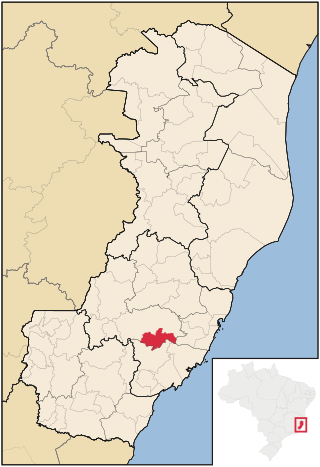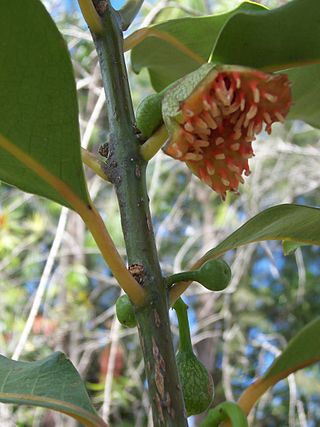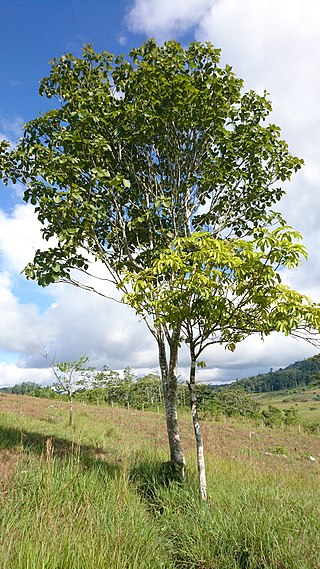
Marechal Floriano is the capital of a municipality of the same name in the state of Espírito Santo, Brazil. Once part of the municipality of Domingos Martins, the town of Marechal Floriano separated on October 31, 1991, becoming capital of its own municipality. Marechal Floriano is just over 60 km from Vitória, the capital of the state, and situated in the southeastern Brazilian Highlands. The surrounding municipalities are to the north, Domingos Martins, and to the south, Guarapari and Alfredo Chaves. The capital stands at 544 meters above sea level. Local average temperatures vary between 6 and 30 degrees Celsius.

Gavião Peixoto is a municipality in the state of São Paulo in Brazil. The population is 4,815 in an area of 244 km². The elevation is 515 m.

The Monimiaceae is a family of flowering plants in the magnoliid order Laurales. It is closely related to the families Hernandiaceae and Lauraceae. It consists of shrubs, small trees, and a few lianas of the tropics and subtropics, mostly in the southern hemisphere. The largest center of diversity is New Guinea, with about 75 species. Lesser centres of diversity are Madagascar, Australia, and the neotropics. Africa has one species, Xymalos monospora, as does Southern Chile. Several species are distributed through Malesia and the southwest Pacific.

Antônio Frederico de Castro Alves was a Brazilian poet and playwright famous for his abolitionist and republican poems. One of the most famous poets of the Condorist movement, he wrote classics such as Espumas Flutuantes and Hinos do Equador, which elevated him to the position of greatest among his contemporaries, as well as verses from poems such as "Os Escravos" and "A Cachoeira de Paulo Afonso", in addition to the play Gonzaga, which earned him epithets such as "O Poeta dos Escravos" and "republican poet" by Machado de Assis, or descriptions of being "a national poet, if not more, nationalist, social, human and humanitarian poet", in the words of Joaquim Nabuco, of being "the greatest Brazilian poet, lyric and epic", in the words of Afrânio Peixoto, or even of being the "walking apostle of Condorism" and "a volcanic talent, the most enraptured of all Brazilian poets", in the words of José Marques da Cruz. He was part of the romantic movement, being part of what scholars call the "third romantic generation" in Brazil.
Crossodactylodes is a genus of leptodactylid frogs from the Atlantic Forest of eastern Brazil.

Ethnography and History Museum of Póvoa de Varzim is a museum with a maritime and ethnic theme located in the Portuguese city of Póvoa de Varzim. The museum is located in Solar dos Carneiros, former home of the Viscount of Azevedo.
Embraer Unidade Gavião Peixoto Airport is a private airport located near Gavião Peixoto, São Paulo, Brazil. It is owned and operated by Embraer and used for testing civil and military aircraft.

Madame Satã is a 2002 Brazilian–French drama film directed by Karim Aïnouz. Shot in the neighborhoods of Lapa, Glória, Paquetá, and Centro in the Rio de Janeiro city, it tells the story of Madame Satã and premiered in the Un Certain Regard section at the 2002 Cannes Film Festival.

Alexandre Pires do Nascimento is a Brazilian singer-songwriter. Pires was previously the singer of group Só Pra Contrariar which he joined in the late 1980s.

Limite is a Brazilian silent experimental psychological drama film directed, written and produced by Mário Peixoto, who was inspired by a photograph by André Kertész. Limite was filmed in 1930 and first screened in 1931. It was restored from 1966 to 1978 from a single damaged nitrate print, and one scene remains missing. It is widely regarded as the first experimental feature film made. In a small boat adrift, two women and a man remember their recent past. They no longer have the strength or desire to live and have reached the limit of their existence.

Antônio Carlos Peixoto de Magalhães, also known by his initials ACM, was a Brazilian politician. He served as Governor of Bahia three times and represented Bahia in the Senate of Brazil three times. Magalhães was one of Brazil's most powerful politicians serving as a Minister for Communications, as Leader of the Liberal Front Party (PFL) and as President of the Federal Senate.
Crossodactylodes bokermanni is a species of frog in the family Leptodactylidae. It is endemic to Espírito Santo state of eastern Brazil. While its range is small, it is locally abundant. It is an arboreal species living in forests near 560 m (1,840 ft) altitude. It is associated with epiphytic bromeliads where its tadpoles develop. It is threatened by habitat loss.
Crossodactylodes izecksohni is a species of frog in the family Leptodactylidae. It is endemic to Santa Teresa in Espírito Santo state of eastern Brazil.

Proceratophrys is a genus of frogs in the family Odontophrynidae. They are found in eastern and southern Brazil, northeastern Argentina, and Paraguay, possibly into Bolivia adjacent to the Brazilian border.
Dasypops is a genus of frog in the family Microhylidae. It is monotypic, being represented by the single species, the Rio Mutum frog. It is endemic to the coastal plain of Espírito Santo and Bahia states of eastern Brazil. Its natural habitats are lowland forests, including secondary forests and forest edges. It is an explosive breeder that breeds in temporary pools. It is potentially threatened by habitat loss.

Mollinedia is a genus of flowering plants in the family Monimiaceae. There are 56 species distributed in the forests of the Neotropics, ranging from central Mexico to southern Brazil. They are mainly shrubs and trees.

Simira is a genus of plants in the family Rubiaceae. The genus was first published by French pharmacist and botanist Jean Baptiste Christophore Fusée Aublet in Hist. Pl. Guiane vol.1 on page 170 in 1775.

Hydrochus is the only living genus of beetle in the family Hydrochidae, which belongs to the superfamily Hydrophiloidea, and was formerly treated as a subfamily of Hydrophilidae. Hydrochus includes about 180 species, which are found worldwide. The name "Hydrochus" has also been used for a fly genus in the family Dolichopodidae, but this is a junior subjective synonym of the genus Rhaphium.

Peixoto Dam, also known as Mascarenhas de Moraes Hydroelectric Plant, is a hydroelectric dam on the Grande River in the state of Minas Gerais, Brazil, about 20 kilometres (12 mi) west of Delfinópolis.
Grazielanthus is a monotypic genus of flowering plants belonging to the family Monimiaceae. The only species is Grazielanthus arkeocarpus.













